I get this error when I try to login into my ASP.NET MVC5 with Identity Web Application. This application used to be MVC4 until I upgraded to MVC5 because of Identity. In MVC4 it uses a User.cs class while in MVC5 my ApplicationUser is derived from IdentityUser.
Multiple object sets per type are not supported. The object sets 'ApplicationUsers' and 'Users' can both contain instances of type 'RecreationalServicesTicketingSystem.Models.ApplicationUser'.
I read from this question that I needed to remove this line to fix my problem
public System.Data.Entity.DbSet<Manager.Models.ApplicationUser> IdentityUsers { get; set; }
but after removing it I have multiple errors on 'ApplicationUsers' in my ApplicationUserController.cs saying
'ApplicationDbContext' does not contain a definition for 'ApplicationUsers' and no extension method 'ApplicationUsers' accepting a first argument of type 'ApplicationDbContext' could be found
IdentityModels.cs
namespace RecreationalServicesTicketingSystem.Models
{
public class ApplicationUser
: IdentityUser<int, ApplicationUserLogin,
ApplicationUserRole, ApplicationUserClaim>, IUser<int>
{
public async Task<ClaimsIdentity>
GenerateUserIdentityAsync(UserManager<ApplicationUser, int> manager)
{
var userIdentity = await manager
.CreateIdentityAsync(this, DefaultAuthenticationTypes.ApplicationCookie);
return userIdentity;
}
public bool IsAdministrator { get; set; }
[StringLength(50, MinimumLength = 1)]
public string LastName { get; set; }
[StringLength(50, MinimumLength = 1, ErrorMessage = "First name cannot be longer than 50 characters.")]
[Column("FirstName")]
public string FirstMidName { get; set; }
public string FullName
{
get { return FirstMidName + " " + LastName; }
}
[DataType(DataType.Date)]
[DisplayFormat(DataFormatString = "{0:yyyy-MM-dd}", ApplyFormatInEditMode = true)]
public DateTime EnrollmentDate { get; set; }
public int DepartmentID { get; set; }
[ForeignKey("DepartmentID")]
public virtual Department Department { get; set; }
public int DepotID { get; set; }
[ForeignKey("DepotID")]
public virtual Depot Depot { get; set; }
public virtual ICollection<Ticket> Tickets { get; set; }
}
public class ApplicationUserLogin : IdentityUserLogin<int> { }
public class ApplicationUserClaim : IdentityUserClaim<int> { }
public class ApplicationUserRole : IdentityUserRole<int> { }
public class ApplicationRole : IdentityRole<int, ApplicationUserRole>, IRole<int>
{
public string Description { get; set; }
public ApplicationRole() { }
public ApplicationRole(string name)
: this()
{
this.Name = name;
}
public ApplicationRole(string name, string description)
: this(name)
{
this.Description = description;
}
}
public class ApplicationDbContext
: IdentityDbContext<ApplicationUser, ApplicationRole, int,
ApplicationUserLogin, ApplicationUserRole, ApplicationUserClaim>
{
public ApplicationDbContext()
: base("DefaultConnection")
{
}
static ApplicationDbContext()
{
Database.SetInitializer<ApplicationDbContext>(new ApplicationDbInitializer());
}
public static ApplicationDbContext Create()
{
return new ApplicationDbContext();
}
public class ApplicationUserStore :
UserStore<ApplicationUser, ApplicationRole, int,
ApplicationUserLogin, ApplicationUserRole,
ApplicationUserClaim>, IUserStore<ApplicationUser, int>,
IDisposable
{
public ApplicationUserStore() : this(new IdentityDbContext())
{
base.DisposeContext = true;
}
public ApplicationUserStore(DbContext context)
: base(context)
{
}
}
public class ApplicationRoleStore
: RoleStore<ApplicationRole, int, ApplicationUserRole>,
IQueryableRoleStore<ApplicationRole, int>,
IRoleStore<ApplicationRole, int>, IDisposable
{
public ApplicationRoleStore()
: base(new IdentityDbContext())
{
base.DisposeContext = true;
}
public ApplicationRoleStore(DbContext context)
: base(context)
{
}
}
public DbSet<Ticket> Tickets { get; set; }
public DbSet<Category> Categories { get; set; }
public DbSet<Department> Departments { get; set; }
public DbSet<Depot> Depots { get; set; }
public System.Data.Entity.DbSet<RecreationalServicesTicketingSystem.Models.ApplicationUser> ApplicationUsers { get; set; }
}
}
ApplicationUserController.cs
public class ApplicationUserController : Controller
{
private ApplicationDbContext db = new ApplicationDbContext();
// GET: ApplicationUser
public async Task<ActionResult> Index()
{
var applicationUsers = db.ApplicationUsers.Include(a => a.Department).Include(a => a.Depot);
return View(await applicationUsers.ToListAsync());
}
// GET: ApplicationUser/Details/5
public async Task<ActionResult> Details(int? id)
{
if (id == null)
{
return new HttpStatusCodeResult(HttpStatusCode.BadRequest);
}
ApplicationUser applicationUser = await db.ApplicationUsers.FindAsync(id);
if (applicationUser == null)
{
return HttpNotFound();
}
return View(applicationUser);
}
// GET: ApplicationUser/Create
public ActionResult Create()
{
ViewBag.DepartmentID = new SelectList(db.Departments, "DepartmentID", "DepartmentName");
ViewBag.DepotID = new SelectList(db.Depots, "DepotID", "DepotName");
return View();
}
// POST: ApplicationUser/Create
// To protect from overposting attacks, please enable the specific properties you want to bind to, for
// more details see http://go.microsoft.com/fwlink/?LinkId=317598.
[HttpPost]
[ValidateAntiForgeryToken]
public async Task<ActionResult> Create([Bind(Include = "Id,IsAdministrator,LastName,FirstMidName,EnrollmentDate,DepartmentID,DepotID,Email,EmailConfirmed,PasswordHash,SecurityStamp,PhoneNumber,PhoneNumberConfirmed,TwoFactorEnabled,LockoutEndDateUtc,LockoutEnabled,AccessFailedCount,UserName")] ApplicationUser applicationUser)
{
if (ModelState.IsValid)
{
db.ApplicationUsers.Add(applicationUser);
await db.SaveChangesAsync();
return RedirectToAction("Index");
}
ViewBag.DepartmentID = new SelectList(db.Departments, "DepartmentID", "DepartmentName", applicationUser.DepartmentID);
ViewBag.DepotID = new SelectList(db.Depots, "DepotID", "DepotName", applicationUser.DepotID);
return View(applicationUser);
}
// GET: ApplicationUser/Edit/5
public async Task<ActionResult> Edit(int? id)
{
if (id == null)
{
return new HttpStatusCodeResult(HttpStatusCode.BadRequest);
}
ApplicationUser applicationUser = await db.ApplicationUsers.FindAsync(id);
if (applicationUser == null)
{
return HttpNotFound();
}
ViewBag.DepartmentID = new SelectList(db.Departments, "DepartmentID", "DepartmentName", applicationUser.DepartmentID);
ViewBag.DepotID = new SelectList(db.Depots, "DepotID", "DepotName", applicationUser.DepotID);
return View(applicationUser);
}
// POST: ApplicationUser/Edit/5
// To protect from overposting attacks, please enable the specific properties you want to bind to, for
// more details see http://go.microsoft.com/fwlink/?LinkId=317598.
[HttpPost]
[ValidateAntiForgeryToken]
public async Task<ActionResult> Edit([Bind(Include = "Id,IsAdministrator,LastName,FirstMidName,EnrollmentDate,DepartmentID,DepotID,Email,EmailConfirmed,PasswordHash,SecurityStamp,PhoneNumber,PhoneNumberConfirmed,TwoFactorEnabled,LockoutEndDateUtc,LockoutEnabled,AccessFailedCount,UserName")] ApplicationUser applicationUser)
{
if (ModelState.IsValid)
{
db.Entry(applicationUser).State = EntityState.Modified;
await db.SaveChangesAsync();
return RedirectToAction("Index");
}
ViewBag.DepartmentID = new SelectList(db.Departments, "DepartmentID", "DepartmentName", applicationUser.DepartmentID);
ViewBag.DepotID = new SelectList(db.Depots, "DepotID", "DepotName", applicationUser.DepotID);
return View(applicationUser);
}
// GET: ApplicationUser/Delete/5
public async Task<ActionResult> Delete(int? id)
{
if (id == null)
{
return new HttpStatusCodeResult(HttpStatusCode.BadRequest);
}
ApplicationUser applicationUser = await db.ApplicationUsers.FindAsync(id);
if (applicationUser == null)
{
return HttpNotFound();
}
return View(applicationUser);
}
// POST: ApplicationUser/Delete/5
[HttpPost, ActionName("Delete")]
[ValidateAntiForgeryToken]
public async Task<ActionResult> DeleteConfirmed(int id)
{
ApplicationUser applicationUser = await db.ApplicationUsers.FindAsync(id);
db.ApplicationUsers.Remove(applicationUser);
await db.SaveChangesAsync();
return RedirectToAction("Index");
}
protected override void Dispose(bool disposing)
{
if (disposing)
{
db.Dispose();
}
base.Dispose(disposing);
}
}
}
